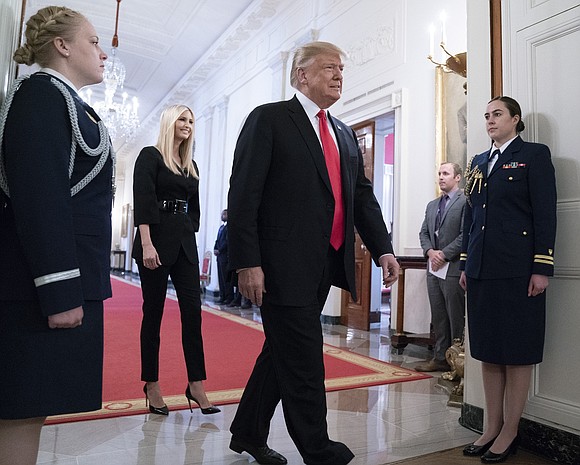Did the White House really create 6.3 million new jobs?
CNN/Stylemagazine.com Newswire | 11/12/2018, 2:15 p.m.
By Lydia DePillis, CNN
(CNN) -- In the middle of the busy week before the midterm elections, the White House held an event in the State Dining Room to advertise what sounded like a milestone: millions of new training opportunities pledged by companies and trade associations, offering pathways to better wages.
"We're up to 6.3 million new jobs," said Ivanka Trump, who has taken on the workforce development portfolio for her father's administration. "That represents 5% of the current workforce. So it's really remarkable."
The event provided a pre-election showcase for the administration's efforts to seed better-paying careers across the US. But the idea that the pledge was responsible for adding all those jobs — amplified by the White House repeatedly on Twitter in in the final days of the vote — turns out to be exaggerated.
Corporate America may well offer 6.3 million training opportunities in the next five years. According to interviews with many of the pledge's largest signatories, however, the numbers advertised at the Oct. 31 event largely represented a tally of already-planned training programs rather than the brand-new opportunities Ivanka Trump claimed.
Take the Associated General Contractors, a trade group that represents about 26,000 construction companies and suppliers. The organization pledged 172,500 apprenticeships, safety programs, and upskilling courses over the next five years — all steps it planned to take with or without the pledge, a reflection of how difficult construction companies say it is to find enough skilled workers in today's hot economy.
"Our understanding was that the intent of the event was to demonstrate what employer and labor groups were doing to train workers in the United States," says Brian Turmail, the trade group's vice president for public affairs. "It was a way to highlight investments they're already making."
Another construction association, the Associated Builders and Contractors, pledged 500,000 opportunities over the next five years — about as many people as they train annually as a matter of course.
"To be very candid, that number is a number that we heard from both our members and others, just an accumulation of 'I could use that based on the volume of work,'" says Greg Sizemore, the association's vice president for workforce development. "We have to, because of technology, retirement and attrition. You've got to educate."
Other companies and organizations declined to specify how much of their commitment was new and in response to the White House's pledge, but acknowledged that a significant portion had been in the works previously.
The Society for Human Resource Management's pledge of 127,000 opportunities represents the number of people it plans to educate over the next five years through its two certification programs, which it launched two years ago, according to a spokeswoman. General Motors' 10,000 opportunities includes all of its internships, apprenticeship programs, support of vocational training programs, and continuing education programs, including one it started two years ago for people returning to the workforce after taking a break.
FedEx pledged 512,000 opportunities, including employees who take advantage of its longstanding tuition assistance benefit and other pre-existing programs; a spokeswoman would not say whether that represented an increase from FedEx's typical rate.
Walmart pledged a million opportunities over the next five years. That would be roughly the same rate since 2016, when it began launching Walmart Academies, which have now trained about 500,000 associates.
Several companies and associations said that making a public commitment was helpful both to hold themselves accountable and to advertise to potential applicants that their industry offered career pathways at a time when job-seekers have more options than they have had in years.
"What the pledge did for us is it helped us step up even further, cast broader vision, and use it as a rallying cry for our industry," says John Mitchell, president and CEO of IPC, an association of electronics manufacturers that typically certifies about 55,000 people a year and committed to a million opportunities over the next five years — a significant ramp-up over existing numbers.
Mitchell said that reflects the tight job market as much as anything else. "I'm sure some of that stuff would have happened anyway, because frankly, successful companies have to do that," he said.
When asked why all the opportunities represented in the pledge were characterized as "new" even though many would have happened anyway, the White House said it didn't want to exclude companies and associations that already had training programs in place.
Although consistent data on employer training is scarce, experts agree that there is a real need for additional employer investment in training programs in order to keep American workers competitive in the face of globalization and automation. A July 2018 paper from the White House's Council of Economic Advisers noted that the US spends less on training and other programs to get people working than any other developed country, as a percentage of gross domestic product.
Encouraging that investment has been a priority for several past administrations, and workforce development organizations say that there's nothing wrong with publicizing private sector training opportunities through mechanisms like Trump's pledge.
However, they note that public sector investment is important too — and the Trump White House's past two budget proposals have contained drastic cuts to federal funding for workforce training, even though Congress hasn't gone along with them.
"We've consistently heard from this administration these big public calls saying they're focusing on workforce development, but at the same time we've seen a lot of focus on eliminating programs or streamlining programs," says Katie Spiker, who leads federal policy for the National Skills Coalition.
Public funding is particularly important for smaller employers who can't necessarily invest in large-scale training programs, Spiker says, as well as to create support services like transportation and child care to make it easier for workers to complete their training.
Although at last week's event National Economic Council Director Larry Kudlow said that the commitments included "no government money," a few signatories said that their commitments did include some opportunities supported by federal funding. For example, the Associated General Contractors provides safety training to 700 workers per year thanks to the Department of Labor's Susan Harwood grant program, which the White House's proposed fiscal year 2019 budget would have eliminated.
In response, the White House said that the vast majority of opportunities represented in its pledge were funded by private money, and that they didn't screen out those that were subsidized by taxpayers.
That includes the National Restaurant Association Educational Foundation, which pledged almost 370,000 opportunities on behalf of members. Some apprenticeships are supported by federal grants, but Executive Vice President Rob Gifford says the Foundation is committing millions of dollars to the effort, too. "The overwhelming majority is member money," he said.




